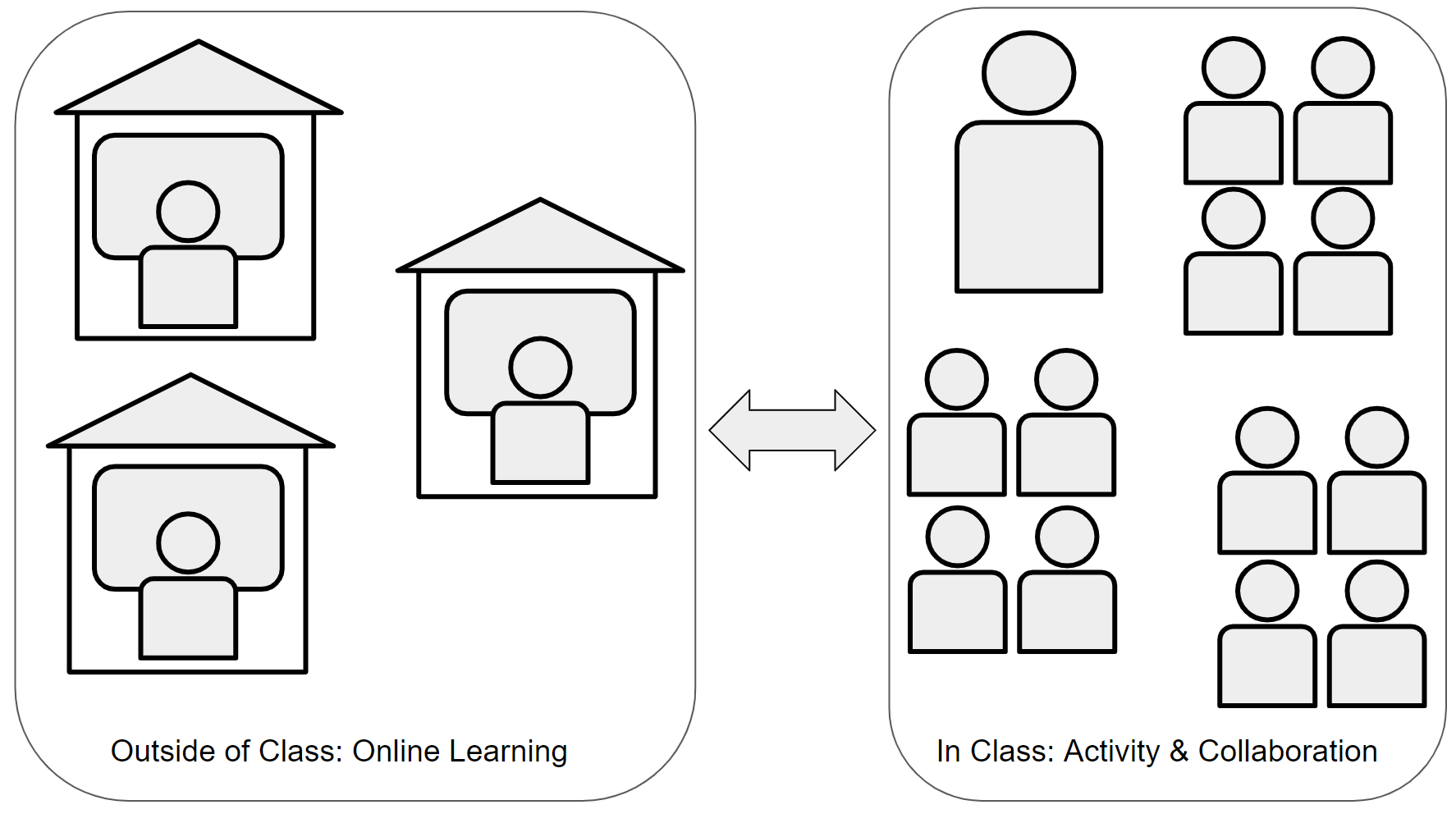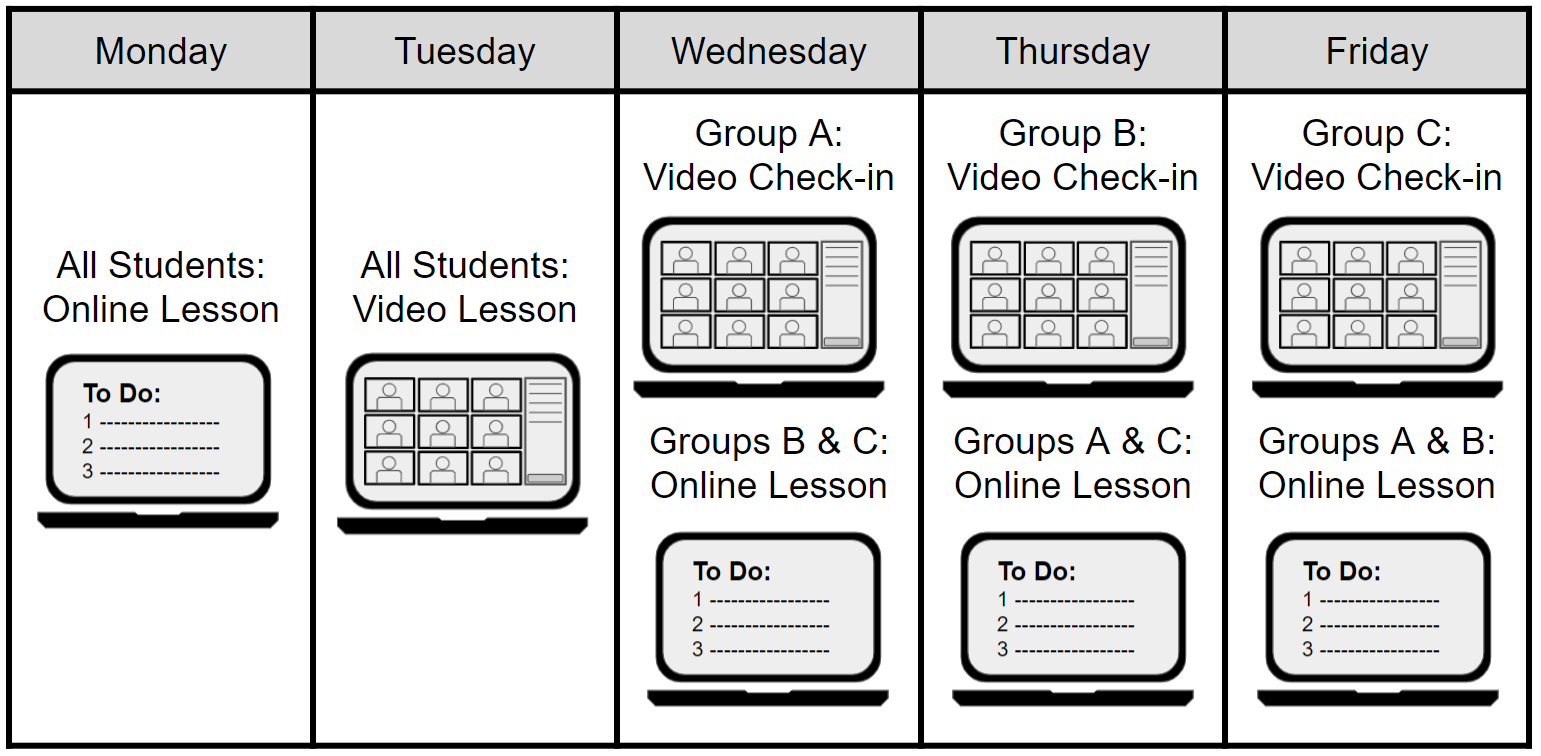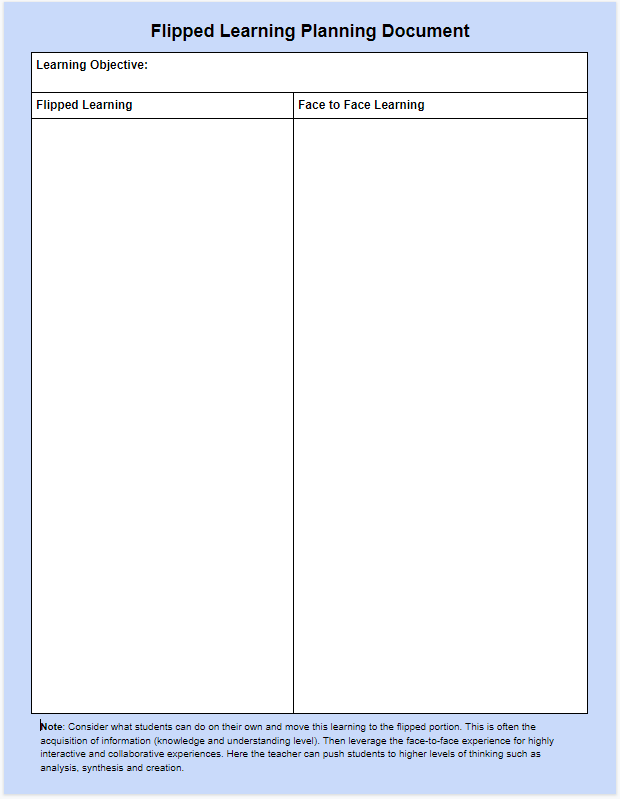While flipped learning can stand on its own as an effective blended-learning model, it is much more versatile than that. In fact, flipped learning is regularly integrated into nearly every other blended-learning model. By understanding the concepts and practices of flipped learning, you can improve your implementation of all blended-learning models.
What Is Flipped Learning?
In its most classic sense, flipped learning is the flipping of what happens at school and what happens outside of class. For example, instead of listening to a lecture or reading an article at school, students do this on their own time after school hours. Similarly, instead of doing application or practice on their own at night, this work is completed during class time. By flipping these two experiences, students can acquire the instructional input on their own while having the teacher present in class to answer their questions, support them, and help them apply their new learning.
By flipping these experiences, the teacher is also maximizing face-to-face time for work that requires the most cognitively complex tasks (analysis, synthesis, creation, evaluation). This is where students are stretched and grow the most, and it is during this phase of learning that they will most need their teacher’s support. The instructional input is generally less cognitively complex, and students are often able to complete this phase of learning on their own, especially since it is often a more passive experience. If they do have questions, they can follow up with their teacher during the in-person class session.

During flipped learning, direct instruction happens virtually outside of class, while in-class time is leveraged for engaging activities and student collaboration. This model increases the level of engagement and higher-order thinking during face-to-face time.
A Spin on Flipped Learning
While flipping in-class and out-of-class learning is the traditional flipped-learning model, teachers have found creative ways to maximize the potential of flipped learning by integrating it into the other blended-learning models. Perhaps the most common spin that teachers put on flipped learning is a strategy called the “in-class flip.” Instead of flipping what happens outside of class with what happens in class, the teacher conducts all parts of the lesson in class but flips the in-class lectures and direct instruction to a video, reading, or computer application. As with the classic flip, this frees up the teacher to support students as they work on application and higher-order thinking skills. These flipped components can be integrated into stations, playlists, and whole-group lab time depending on your instructional need.
The Benefits of Flipped Learning
The basic concept of flipped learning is quite simple, but its benefits can be profound.
Increased Student Engagement
Jon Bergmann, one of the originators of flipped learning, stresses that the power of the flipped classroom is not the videos. Rather, it’s the increased student engagement that is possible because of the flip. He says, “It’s time to change from passive learning to active learning, so we can reach every student every day.”
Increased Inquiry and Higher-Order Thinking Opportunities
At the 2018 iNACOL Symposium, Bergman stressed the importance of using in-class time to “give them [students] projects and inquiry activities. That’s where the magic will really happen.” Students should be applying, analyzing, and creating in class.
Increased Individualized Student Contact
Bergmann also stresses that at the core of flipped learning is an intent to “give struggling students more of what they need—me [the teacher].” Full-class instruction limits relationship building with students. Being freed up to interact with students one-on-one and in smaller groups goes a long way to helping establish deeper relationships with them. Bergman also says, “Flipped learning comes down to relationships,” and this helps to turn the classroom into “an active place of learning where there is someone there for them [each student].”
Increased Achievement
Bergmann points out that flipped learning has been highly researched (over 500 studies), and the vast majority point to increased student achievement. In fact, there are now entirely flipped universities, and even Harvard Medical School has adopted the flipped approach. Flipped learning has also been shown to increase the depth of learning due to the increased level of engagement in class.
What if Students Don’t Watch the Videos?
This is a common question, and it can complicate the in-class portion of your lesson. While there is no one perfect solution to this, there are a few effective strategies that you can apply.
Set clear expectations and hold students accountable to them.
The first step is to make sure that students know what they are supposed to do and how to do it. If they don’t understand your directions, they can’t complete the task. Then, as with any other classroom expectations, the second step is to make sure that there are natural consequences if they choose not to do the work. It’s important to note that these consequences are not punishments. Rather, they are opportunities to redirect our students in ways that increase their chances for success.
Require students to watch the videos when they get to class.
On the surface, this may not seem like a consequence at all, and yes, this will mean that students will miss out on some of the other learning activities you have planned. However, if the content is core to engaging in the next phase of learning (and it should be if you’re assigning it), students need to complete this work. Allowing them to skip it will not only send the wrong message but also put the student at an academic disadvantage.
Create in-class activities that students don’t want to miss.
Other than making the videos engaging and meaningful, the best way to motivate students to watch your videos outside of class is to create in-class activities that they don’t want to miss. If these are fun, mentally stimulating, and interactive, most students will want to be part of it. Missing this portion of the lesson may be the natural consequence of not doing the prior work, and it can motivate students to watch the videos in the future.
Find out why they didn’t do the work.
Be careful not to assume that students are just being lazy or avoiding your assignments. Some students might not have reliable internet at home, leaving them unable to view the content. Others may not have a home environment that is conducive to learning, or maybe your student is responsible for the care of siblings on evenings when their parents/guardians are at work. By taking the time to understand the reason that the work has not been completed, you can work with the student (and family) to find a solution.
A Flexible Strategy for Your Face-to-Face, Remote, or Hybrid Classroom
The flipped-learning approach can be used very effectively in face-to-face classrooms, remote-learning settings, and also hybrid-learning environments.
The face-to-face classroom is ideal for either traditional or in-class flipped strategies.
Traditional Flipped Learning
This is the simplest place to begin. Start with a concept or content that will be easy for students to understand. Create a short video or screencast introducing the concept to your students and have them watch this at home. You may want to include some sort of initial processing activity to help them internalize the content. This might be as simple as having them take notes, write a reflection, or complete a brief formative quiz to check for understanding.
When students come to class the next day, engage them in activities that apply, extend, and enrich their understanding of the content. Maximize this face-to-face time for getting the students to think at a higher, more complex cognitive level and get them collaborating and interacting. Because the content acquisition has already taken place, you now have more face-to-face time to create exciting, engaging learning experiences in your classroom.
In-Class Flip
This approach gives you an opportunity to take flipped learning to the next level. The in-class flip is incredibly helpful when implementing other blended-learning models in your classroom. In many ways, the flipped component makes the other models feasible. For instance, during station rotation, teachers can effectively “clone themselves” by providing video directions and instruction at each station. Students can watch this recording on their own (or in groups) and complete the station activities while the teacher works with individual or small groups of students at a teacher station. Similarly, in whole-group rotation, students are often introduced to new content in the lab setting via flipped content. This content may be delivered through a video, text-based, or interactive software. The blended-learning playlist model frequently includes flipped learning as part of the choice boards that students may complete, as well. Whatever the context for integrating flipped learning (traditional or in-class), the key objective is to maximize student-to-teacher interaction time and create learning experiences that stretch students to higher-order thinking.

In this image, students experience various elements of flipped learning as they rotate through stations. Each station integrates technology to a different degree, and students experience a blend of online and offline learning. The in-class flipped recordings allow students to be independent while the teacher has time to meet with groups of students.
Remote learning is often rich with flipped learning, but because the face-to-face time is not in person, this has a different look and feel to it. In fact, most (if not all) of the instructional input comes from watching videos, reading text, or interacting with computer software. This component of flipped learning is central to remote-learning success.
Because students will not be physically present in your classroom, the face-to-face time will need to be virtual, as well. One common approach is to use videoconferencing software, like Zoom, Google Meet, or Microsoft Teams, to meet with students. You could choose to bring your entire class together in a meeting, but it may be more effective to meet with smaller groups of students. This will allow you to provide more personalized feedback and answer individual questions. Depending on your schedule, you might even choose to set up one-on-one appointments with each student.
The lack of face-to-face class time during remote learning makes it more important that you create remote-learning experiences that go beyond the simple input of content. You might assign students independent projects to stretch them into application, synthesis, and creation experiences, or you might set students up into virtual groups and have them work together on these activities. Remote groups may be more effective with older students who can be more independent and find ways to reach out to each other without as much teacher facilitation.
As with face-to-face learning, the flipped experience can also be modified to work with stations and playlists.

When integrating flipped learning into a remote-learning schedule, the face-to-face component is generally a videoconference with the teacher. In this illustration, the teacher is using a combination of full-class video meetings and small-group check-ins.
If you are teaching in a hybrid schedule, you will likely draw from both the face-to-face and remote-learning options. This makes sense because you are essentially implementing both of those experiences over the course of your A/B schedule. Think of this as a full-group rotation model over the course of two days. One day is the virtual lesson, and the next day is the face-to-face component.
During remote-learning days, students will complete a full virtual lesson that sets them up for their face-to-face time with you. You’ll need to create a lesson that they can work through without you being physically present. Oftentimes, this will include a video or screencast, but it may also be rich with text and interactive online content. The main difference between this and the traditional flipped model is that students will only see you every other day. Therefore, you will need to add in more application and processing activities during the remote day. Simply viewing a video will not be enough since the remote day must be a full academic lesson, not just homework that follows up a lesson. Explore this AVID Open Access article for ways to make screen time more actively engaging for students.
In-class days can become the highly interactive application day, or they can include a blend of station rotation and flipped lessons, as well. This is your face-to-face time, so maximize the opportunity for human interaction. This is your opportunity to get students collaborating, discussing, and working together. It’s also your chance to meet with students individually or in groups.

In a hybrid model, the remote days are typically the flipped-learning days, while the in-class days are leveraged for interactive and collaborative learning experiences, like labs, discussions, projects, and group work. In this particular example, all students are remote on Fridays, so this teacher has chosen a video class meeting for everyone, but this also could have been an online lesson.
Resources to Support Flipped Learning
While the delivery of flipped content can be done in many ways (text, websites, software, audio, research projects), the most common delivery method is through video. For that reason, this section will explore the art and craft of creating, finding, and delivering video content to students.
- Choose your tool. To create your own videos, you will need video capturing software. The most common approach is to record your computer screen as you speak. There are several quality options available that are free:
- Tips for creating quality videos:
- Plan your message. Make sure that you know what you are going to share. Don’t ramble!
- Plan your visuals. What you show is equally important to, if not more important than, what you say. Popular options are using slideshows, document cameras, and website content. Show as you tell.
- Move faster than normal. Stay on message and don’t repeat yourself. Viewers can always pause and watch a section again if they missed something or need to hear it again.
- Keep it short. Try to keep your videos to 5–7 minutes or less. Two minutes is even better! Several short videos can be more effective than one longer one. The younger the student, the shorter the video should be.
- It doesn’t need to be perfect. The message should be accurate, but small stutters in delivery are fine. We’re not perfect live either.
You don’t need to create your own videos if you can find quality material that’s already made. Here are some video sources to explore:
- SchoolTube: This site has mainly videos.
- TeacherTube: This site has video, audio, docs, collections, playlists, etc.
- Khan Academy: Math, and much more! Create classrooms and track progress.
- TED-Ed: The TED-Ed Student Talks program supports students as they discover, explore, and present their big ideas in the form of short, TED-style talks.
Your students will be more successful completing flipped lessons if you design ways for them to engage in the content as they view your videos.
- Edpuzzle (Tips): Embed questions into your video. View analytics on a teacher dashboard.
- Video note-taking: Set up a structure for your students to take notes as they view your videos. ReClipped and YiNote are handy options.
- Digital reading strategies: If you include text content as part of your flipped lesson, provide your students with ways to critically read and mark up digital text.
- Note-Taking: Teaching students to take focused notes can greatly increase their retention of content. Digital note-taking tools can help make this process even more effective.
To help you get started, make a copy of the Flipped Learning Planning Document and begin flipping your classroom.

Extend Your Learning
- A Flipped Learning Flow for Blended or Online Classes (Catlin Tucker)
- Flipped Classroom 101: Challenges, Benefits and Design Tips (Catlin Tucker)
- Flipped Learning Simplified (Jon Bergmann)
- Flipped Classroom (video) (Pasco County Schools)
